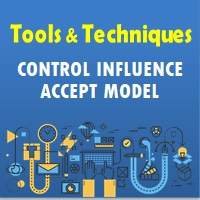
What Is the Control Influence Accept Model?
The Control Influence Accept model was first developed by HR specialist Neil Thompson and social-work lecturer Sue Thompson in their 2008 book, “The Critically Reflective Practitioner.” It’s a versatile time- and stress-management tool that identifies three ways you can respond to challenges:
- Control them – identify the elements of the situation that you can control.
- Influence them – identify the elements that you can’t control, but that you can influence.
- Accept them – identify the elements that you can neither control nor influence, and adapt accordingly.
When you understand these three potential responses, you can put problems into perspective more easily and get a sense of what you can and can’t accomplish. This enables you to focus your efforts where they’ll have the most impact, and to reduce stress, as self-development expert Roger Seip explains in his article on the CIA Model of Stress Reduction.
You can use a diagram to help you to apply the Control Influence Accept Model to your own life or to a group problem.

How to apply this model?
Follow these four steps next time you want to tackle a situation that has become overwhelming:
- Describe the situation. What has happened and why has it become difficult? List every aspect of it that makes it overwhelming. This encourages people to be candid about the problems that th’ey’re facing.
- Sort and place items on the diagram. Once you’ve completed your list, write each item down on a separate sticky note and place it on the area of the diagram that it belongs in – control, influence, or accept/adapt.
- Consider each item in turn. Ask yourself or discuss with your team whether it’s something that you could realistically control. Can you solve the problem using existing resources? Or will you need outside help? If you believe you can realistically control even part of the problem, place it in the Control section of the diagram. If you think the situation is beyond your control, consider whether it’s something you can influence. Do you, for example, have useful skills or knowledge that you can provide to someone else to solve the problem? If so, add it to the Influence section of the diagram. Place the remaining problems in the Accept/Adapt part of the diagram.
- Take action. When you’re done sorting through the problems, address each section of your diagram in turn, starting with the things that you can control.


